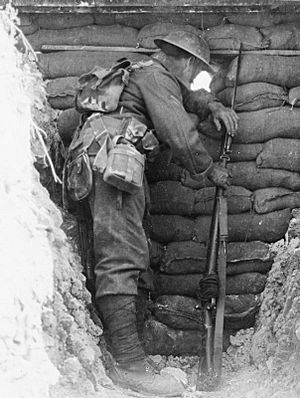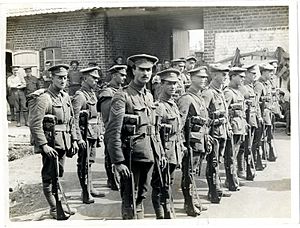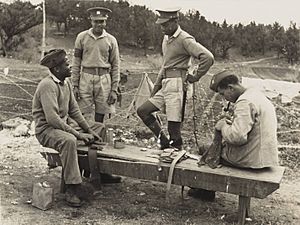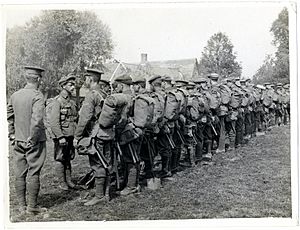1908 Pattern Webbing facts for kids

The 1908 Pattern Web Infantry Equipment was a new kind of gear used by the British Army before World War I. It was made from strong woven cotton, called webbing. This equipment helped soldiers carry their supplies, ammunition, and tools more easily.
Why New Gear Was Needed

Before 1908, British soldiers used leather equipment. During the Second Boer War (1899–1902), this old leather gear, called the Slade-Wallace Equipment, caused problems. Soldiers found it heavy, awkward, and hard to balance.
After the war, a special group looked into these issues. They heard that the old equipment was "absurd" and "badly balanced." As a quick fix, they tried another leather set, but it still wasn't right for soldiers fighting on foot.
In 1906, a soldier named Major Arnold R. Burrowes worked with the Mills Equipment Company. This company had already made woven cotton gear for the US Army. Together, they designed a new type of equipment. After successful tests, the British Army decided to use this new webbing gear in December 1907.
What the Equipment Looked Like
The 1908 equipment was designed to fit together like one piece. Soldiers could put it on or take it off almost like a jacket. Ammunition was kept in two sets of pouches at the front, on the belt. Straps from these pouches went over the shoulders and crossed at the back.
This design helped spread the weight of a soldier's gear. A large pack (called a "valise") or a smaller bag (called a "haversack") could be attached to these straps. The metal buckles and strap ends were made of brass.
The main parts of the 1908 equipment included:
- A wide belt
- Two shoulder straps (braces)
- A holder for a bayonet (a knife attached to a rifle)
- A water bottle and its carrier
- A haversack (a small bag for food and personal items)
- A valise (a large pack for extra clothing and gear)
- Straps for the valise
- A small shovel (entrenching tool) with separate carriers for its head and handle
Soldiers could set up their equipment in two main ways:
- Full Marching Order: For long journeys, the large valise was worn on the back, and the smaller haversack hung at the left hip.
- Battle Order: For combat, the large valise was removed. The haversack was moved to the back, connected to the ammunition pouches.
Later, in 1917, another small bag was added to hold a gas mask. This bag was worn high on the chest.
A soldier's full marching gear was supposed to weigh about 57 pounds (26 kg). In battle, it was around 49 pounds (22 kg). However, during wartime, soldiers often carried much more. With extra ammunition, gas masks, steel helmets, and hand grenades, their load could sometimes be as heavy as 114 pounds (52 kg)!
How the Equipment Was Used

The 1908 Pattern Web Equipment was the main gear used by British and Imperial armies during World War I. The company making the equipment couldn't keep up with the huge demand. Because of this, a leather version was made in 1914. This leather gear was meant for training, but it often ended up being used by soldiers on the front lines.
About 20 years after World War I, the 1908 webbing was replaced by the 1937 Pattern Web Equipment. However, because so many soldiers were needed at the start of World War II, the 1908 webbing was still used for some time. Some British soldiers in places like India and Hong Kong were still using it in 1941. The large valise from the 1908 set even continued to be used with the newer 1937 equipment.


